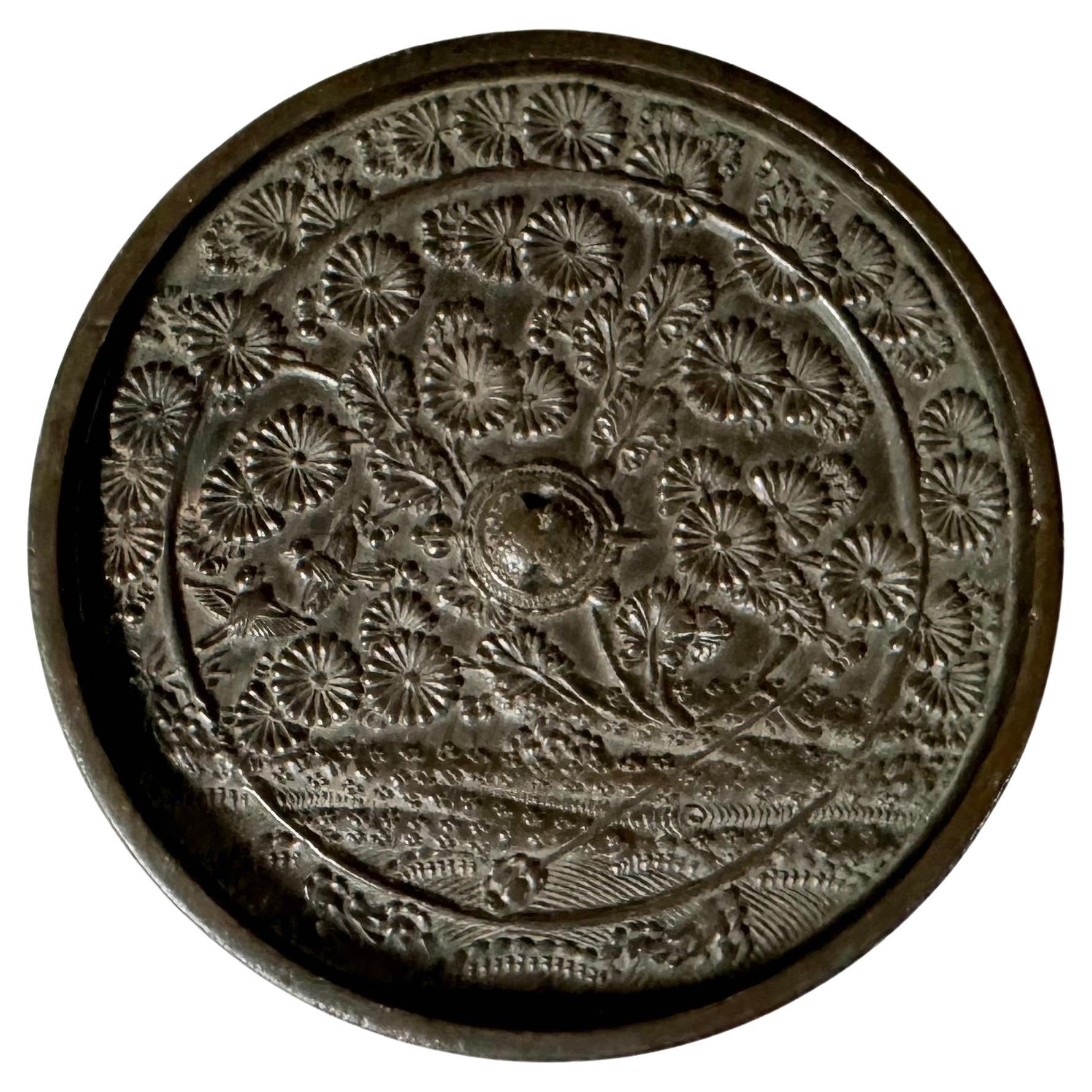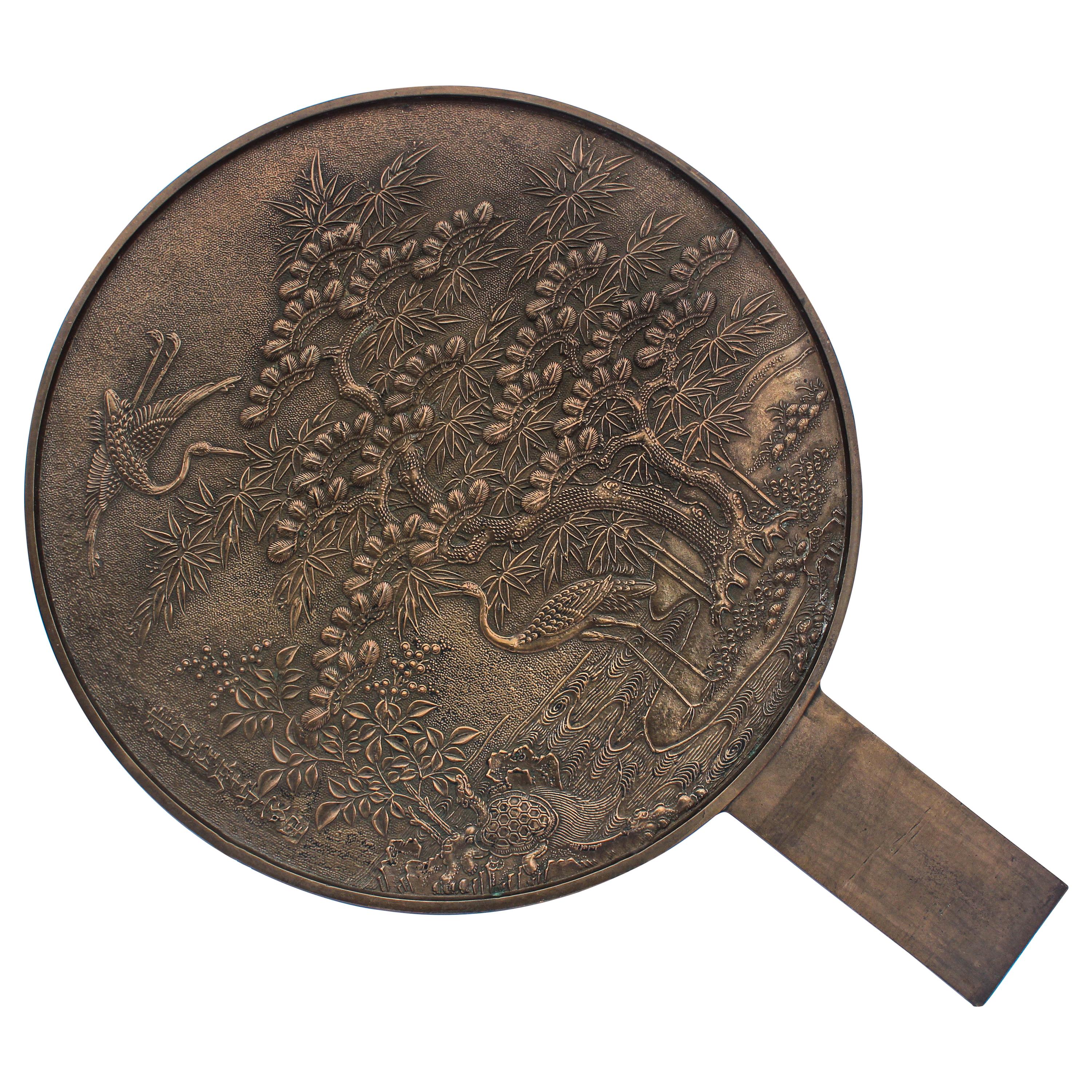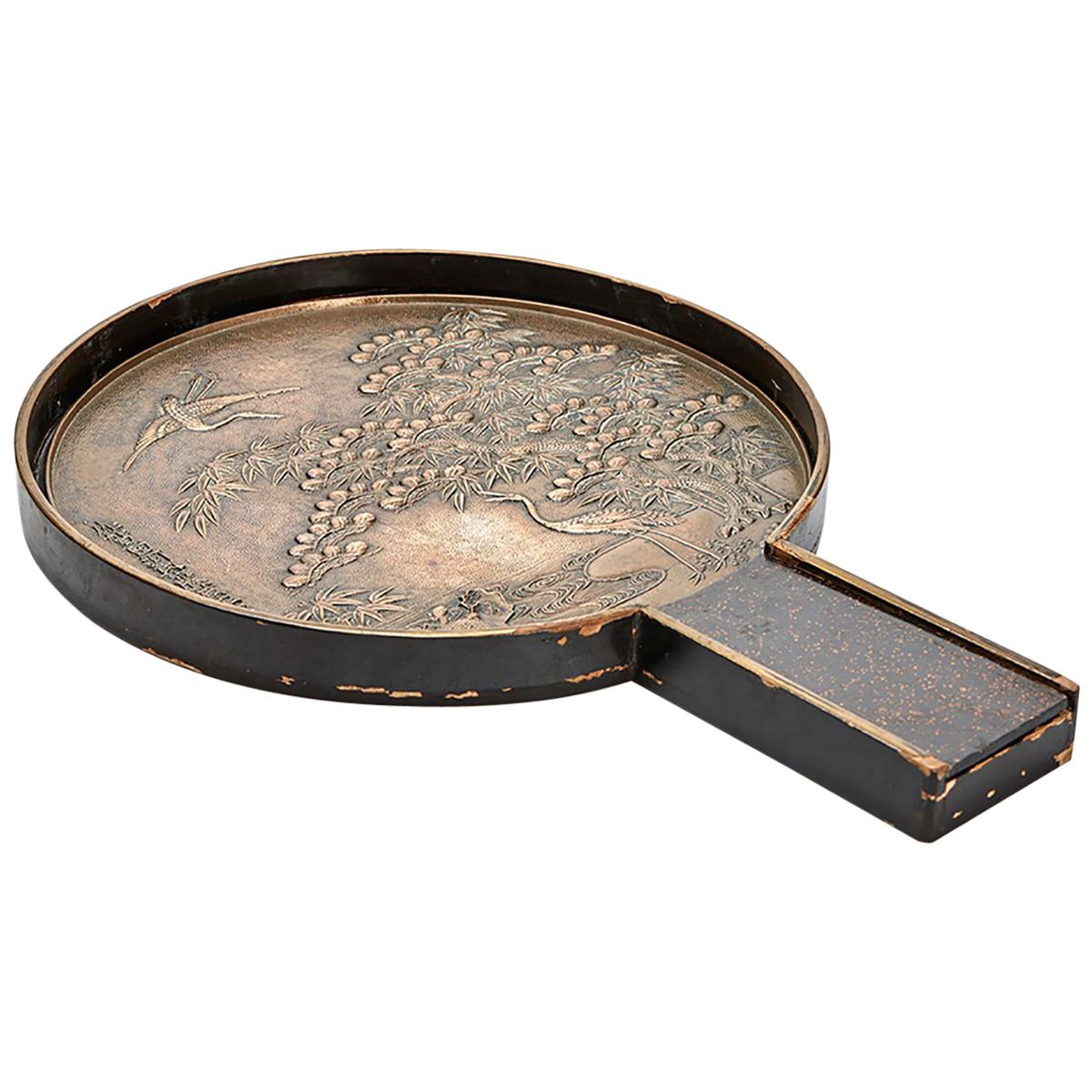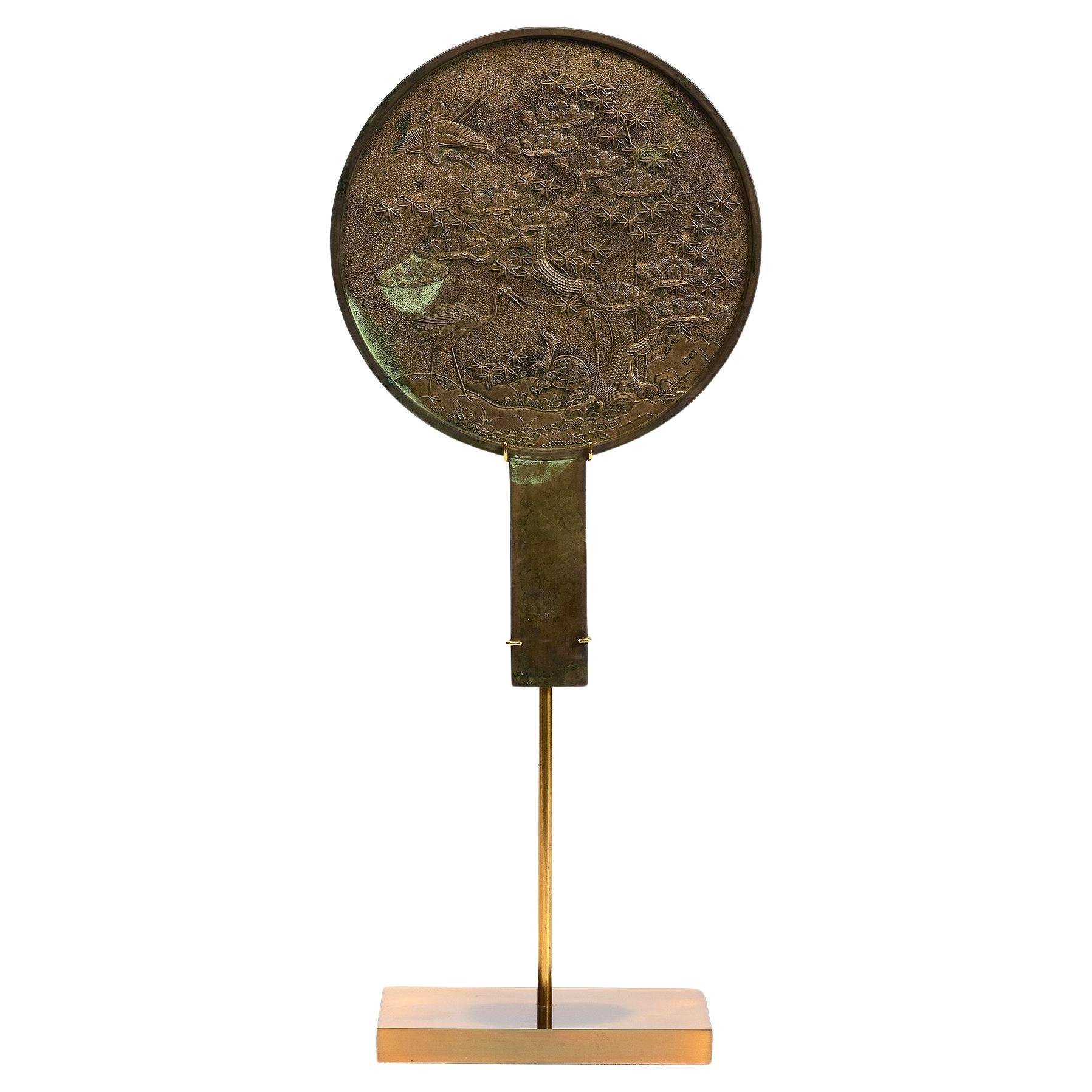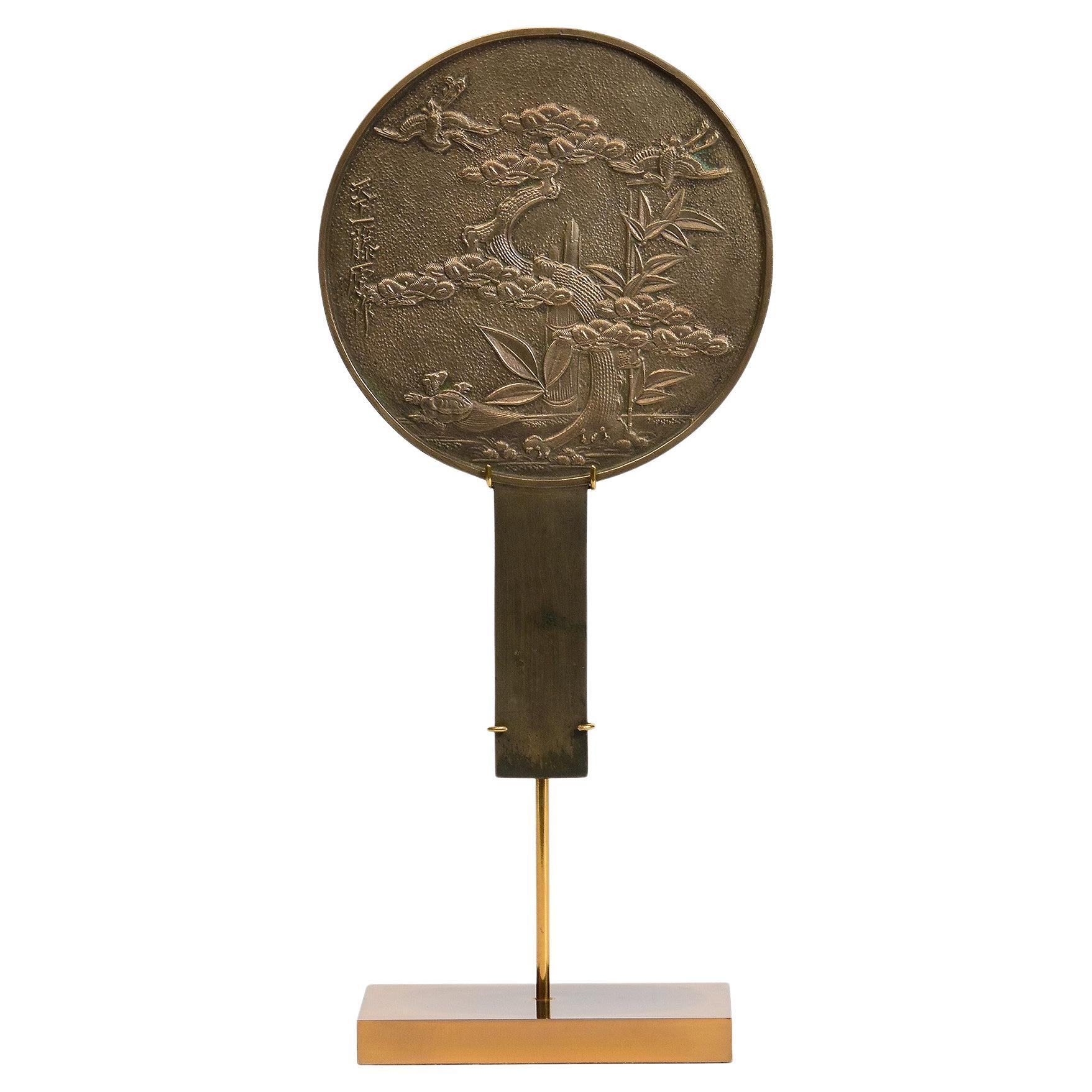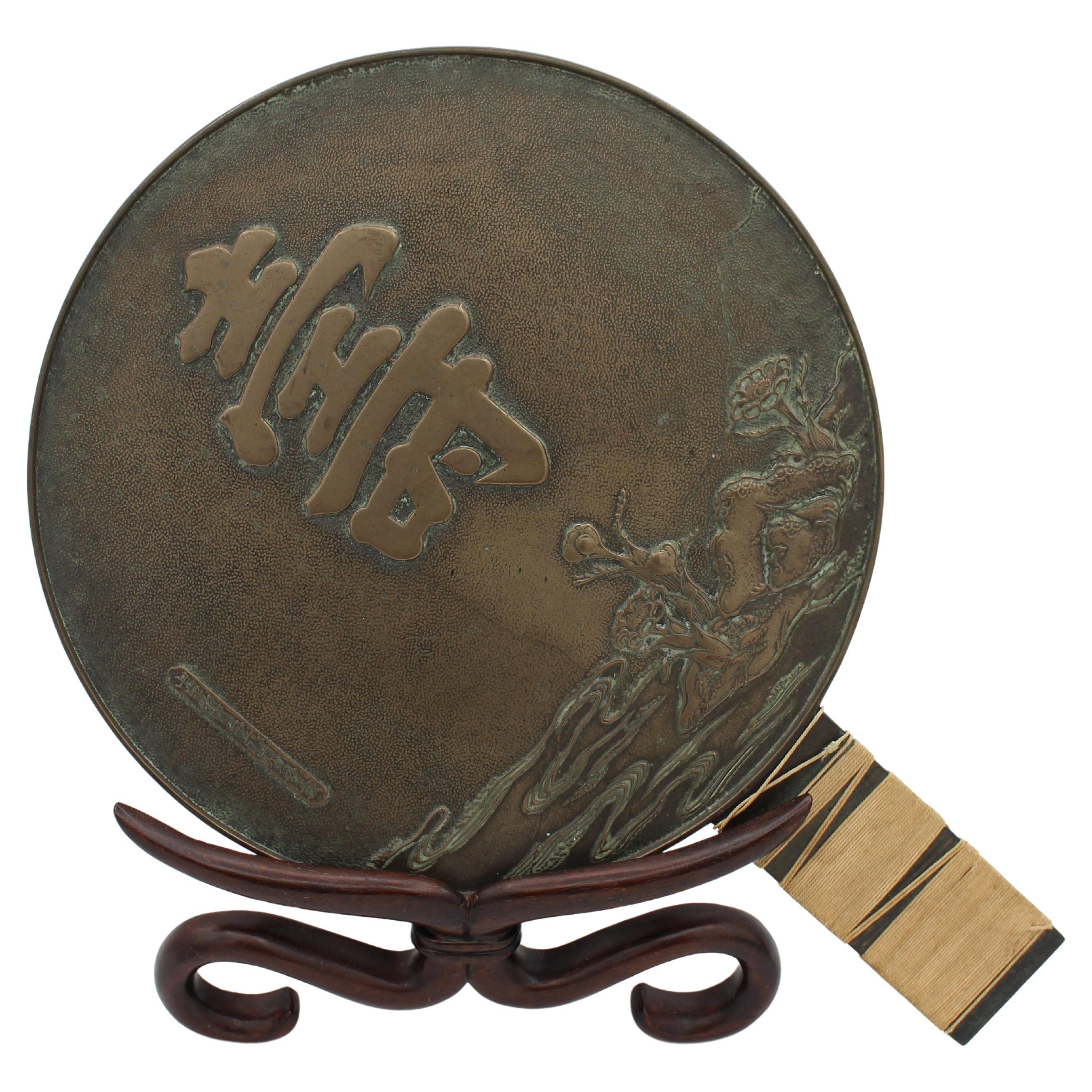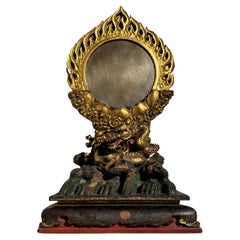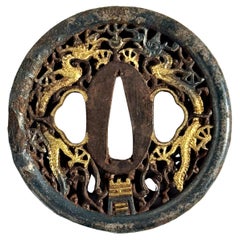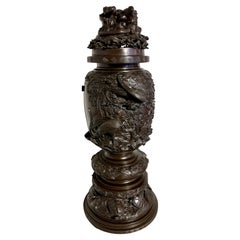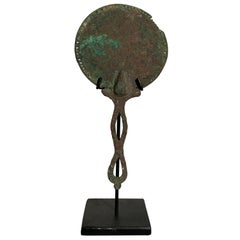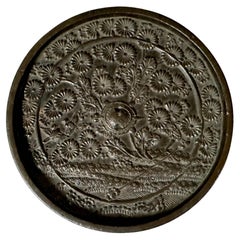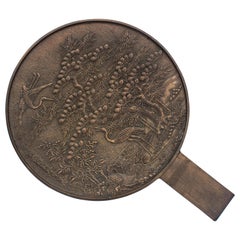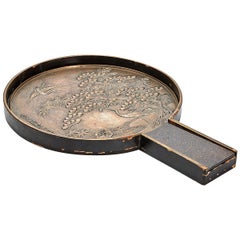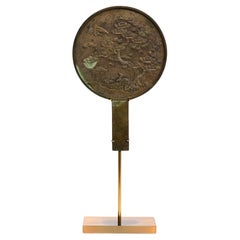Items Similar to Japanese Cast Bronze "Longevity" Mirror, Edo Period, 18th Century, Japan
Want more images or videos?
Request additional images or videos from the seller
1 of 9
Japanese Cast Bronze "Longevity" Mirror, Edo Period, 18th Century, Japan
$1,350
£1,025.09
€1,172.26
CA$1,886.15
A$2,097.81
CHF 1,095.41
MX$25,528.07
NOK 13,990.04
SEK 13,120.19
DKK 8,749.05
Shipping
Retrieving quote...The 1stDibs Promise:
Authenticity Guarantee,
Money-Back Guarantee,
24-Hour Cancellation
About the Item
A heavy and finely cast Japanese bronze mirror with longevity symbols, Edo Period, 18th century, Japan.
The small, round mirror with high walls has been intricately and exquisitely cast with symbols of longevity. The mirror is centered around a turtle, its domed shell pieced to allow a cord to be strung through for handling or hanging. Turtles are a symbol of longevity in Chinese and Japanese culture. A two character mark is cast below, reading "tenka", meaning "under heaven".
Surrounding the turtle and inscription is a densely cast landscape featuring pine trees with fantastic needles, a crane with its two young, and dense stalks of leafy bamboo. All are symbols of longevity. Bamboo also symbolizes resilience and prosperity.
Above the turtle, nestled between the pine, are two kamon, or family crests. On the left is the gosan kiri mon, a paulownia leaf with an arrangement of flowers to the top in the 3-5-3 pattern. On the right is a karahana mon, a mythical Chinese flower.
The other side of the mirror is undecorated, and would originally have been highly polished, allowing the user to see their reflection in the polished surface.
The bronze with a wonderful, warm patina.
- Dimensions:Height: 0.63 in (1.61 cm)Diameter: 4.75 in (12.07 cm)
- Style:Edo (Of the Period)
- Materials and Techniques:Bronze,Cast
- Place of Origin:
- Period:
- Date of Manufacture:Mid-Late 18th Century
- Condition:Wear consistent with age and use. The back with light scratches and stains, as seen in photos.
- Seller Location:Austin, TX
- Reference Number:1stDibs: LU894725418452
About the Seller
5.0
Platinum Seller
Premium sellers with a 4.7+ rating and 24-hour response times
Established in 2001
1stDibs seller since 2010
345 sales on 1stDibs
Typical response time: <1 hour
- ShippingRetrieving quote...Shipping from: Austin, TX
- Return Policy
Authenticity Guarantee
In the unlikely event there’s an issue with an item’s authenticity, contact us within 1 year for a full refund. DetailsMoney-Back Guarantee
If your item is not as described, is damaged in transit, or does not arrive, contact us within 7 days for a full refund. Details24-Hour Cancellation
You have a 24-hour grace period in which to reconsider your purchase, with no questions asked.Vetted Professional Sellers
Our world-class sellers must adhere to strict standards for service and quality, maintaining the integrity of our listings.Price-Match Guarantee
If you find that a seller listed the same item for a lower price elsewhere, we’ll match it.Trusted Global Delivery
Our best-in-class carrier network provides specialized shipping options worldwide, including custom delivery.More From This Seller
View AllJapanese Buddhist Mirror and Dragon Stand, Edo Period, early 19th c, Japan
Located in Austin, TX
A powerful and rare Japanese Buddhist "sacred" mirror and stand, Edo Period, late 18th or early 19th century, Japan.
The bronze mirror is housed in a two part gilt wood and lacquer ...
Category
Antique Early 19th Century Japanese Edo Sculptures and Carvings
Materials
Bronze
Japanese Nanban Tsuba with Dragons, Edo Period, early 19th century, Japan
Located in Austin, TX
A dramatic Japanese iron tsuba in the nanban (foreign) style, decorated with dragons and openwork and inlaid with silver and gold, Edo Period, early 19th century, Japan.
The fantast...
Category
Antique Early 19th Century Japanese Edo Metalwork
Materials
Gold, Silver, Iron
Large Japanese Bronze Koro Incense Burner, Meiji Period, 19th Century, Japan
Located in Austin, TX
A large and fantastic Japanese cast bronze incense burner, koro, with high relief design, Meiji period, late 19th century, Japan.
The large and tall koro cast in extremely high re...
Category
Antique Late 19th Century Japanese Meiji Metalwork
Materials
Bronze
Roman Bronze Hand Mirror with Beautiful Patina, circa 1st Century
Located in Austin, TX
A simple and elegant Roman bronze hand mirror, late Republic Period, circa 1st century, Italy.
The bronze mirror of simple form. The round face with a pierced border design. The openwork handle...
Category
Antique 15th Century and Earlier Italian Classical Roman Antiquities
Materials
Bronze
Japanese Bronze Usubata with Waves and Plovers, Edo Period, Mid-19th Century
Located in Austin, TX
An impressive Japanese cast bronze usubata, vessel for ikebana, in the form of a large conical vessel being supported by crashing waves and flying chidori. Edo Period, mid-19th centu...
Category
Antique Mid-19th Century Japanese Edo Metalwork
Materials
Bronze
Japanese Edo Period Lacquer and Mother-of-Pearl Embellished Stoneware Koro
Located in Austin, TX
A highly unusual Japanese crackle glazed koro (incense burner or censer), lacquered and inlaid with mother-of-pearl embellishment, signed Gyokusen, Ed...
Category
Antique 19th Century Japanese Edo Scholar's Objects
Materials
Copper
You May Also Like
Japanese bronze mirror
Located in Stockholm, SE
This exquisite Japanese bronze mirror, measuring approximately 11 cm in diameter, is a rare and enchanting piece of history. Dating back to the 19th century or earlier, it features a...
Category
Antique 19th Century Japanese Metalwork
Materials
Bronze
19th Century Oriental Bronze Japanese Kagami Handled Mirror
Located in North Hollywood, CA
Antique traditional Oriental bronze Japanese Kagami handled Mirror.
An exceptional and stunning Japanese bronze handled mirror called Kagami.
Large and heavy bronze handle mirror ...
Category
Antique Late 19th Century Japanese Meiji Metalwork
Materials
Bronze
Antique Japanese Meiji Bronze Mirror 19th Century
Located in Bishop's Stortford, Hertfordshire
An exceptional and stunning Japanese bronze handled mirror within a fitted black lacquered case. The mirror is polished to one side with the other s...
Category
Antique 19th Century Japanese Meiji Metalwork
Materials
Bronze
Early 20th Century, Showa, Japanese Bronze Mirror with Stand
Located in Sampantawong, TH
Japanese bronze mirror with stand.
Age: Japan, Showa Period, Early 20th Century
Size of mirror only: Diameter 18 C.M. / Height 27.8 C.M.
Size including st...
Category
Early 20th Century Japanese Antiquities
Materials
Bronze
$760 Sale Price
20% Off
Early 20th Century, Showa, Japanese Bronze Mirror with Stand
Located in Sampantawong, TH
Japanese bronze mirror with stand.
Age: Japan, Showa Period, Early 20th Century
Size: Diameter 14.8 C.M. / Height 24.7 C.M.
Size including stand: He...
Category
Early 20th Century Japanese Antiquities
Materials
Bronze
$680 Sale Price
20% Off
Japanese Bronze Mirror, Meiji Period 1868-1912
Located in Chapel Hill, NC
Japanese bronze mirror. Great surface colors; old string handle wrap, Meiji period 1868-1912. Wear from polishing. Extensive inscription. 9 5/16...
Category
Antique Late 19th Century Japanese Meiji Table Mirrors
Materials
Bronze
$180 Sale Price
54% Off
More Ways To Browse
Polished Cast Bronze
Midcentury Japanese Art
Edo Japan
Edo Period Japan
Edo Period Japanese Art
Japanese Antique Marks
Cast Bronze Leaf
Edo Period Gold
Japanese Crane Art
Japanese Art Of Cranes
18th Century Bronze China
Japanese Shell Art
Antique Japanese Mirrors
Gold Mirror Asian
Edo Period Bronze
Gold Crane Japanese
Crane Bronze
Bronze Cranes
